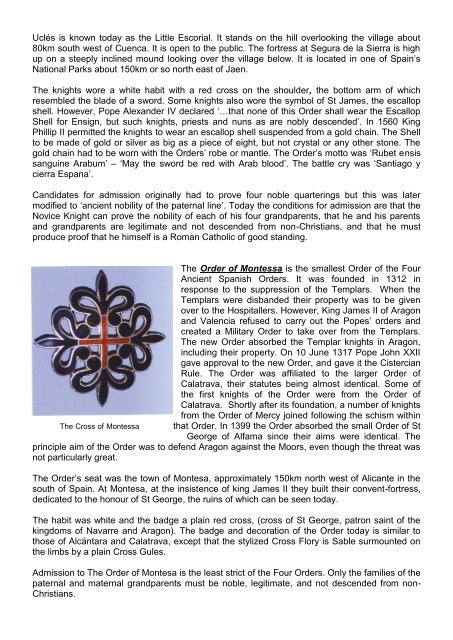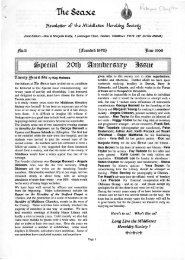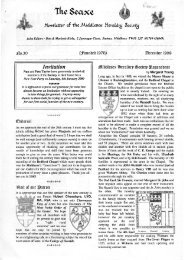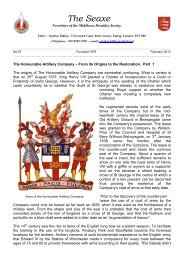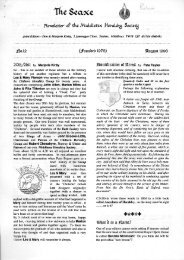The Seaxe - Middlesex Heraldry Society
The Seaxe - Middlesex Heraldry Society
The Seaxe - Middlesex Heraldry Society
Create successful ePaper yourself
Turn your PDF publications into a flip-book with our unique Google optimized e-Paper software.
Uclés is known today as the Little Escorial. It stands on the hill overlooking the village about<br />
80km south west of Cuenca. It is open to the public. <strong>The</strong> fortress at Segura de la Sierra is high<br />
up on a steeply inclined mound looking over the village below. It is located in one of Spain‟s<br />
National Parks about 150km or so north east of Jaen.<br />
<strong>The</strong> knights wore a white habit with a red cross on the shoulder, the bottom arm of which<br />
resembled the blade of a sword. Some knights also wore the symbol of St James, the escallop<br />
shell. However, Pope Alexander IV declared „…that none of this Order shall wear the Escallop<br />
Shell for Ensign, but such knights, priests and nuns as are nobly descended‟. In 1560 King<br />
Phillip II permitted the knights to wear an escallop shell suspended from a gold chain. <strong>The</strong> Shell<br />
to be made of gold or silver as big as a piece of eight, but not crystal or any other stone. <strong>The</strong><br />
gold chain had to be worn with the Orders‟ robe or mantle. <strong>The</strong> Order‟s motto was „Rubet ensis<br />
sanguine Arabum‟ – „May the sword be red with Arab blood‟. <strong>The</strong> battle cry was „Santiago y<br />
cierra Espana‟.<br />
Candidates for admission originally had to prove four noble quarterings but this was later<br />
modified to „ancient nobility of the paternal line‟. Today the conditions for admission are that the<br />
Novice Knight can prove the nobility of each of his four grandparents, that he and his parents<br />
and grandparents are legitimate and not descended from non-Christians, and that he must<br />
produce proof that he himself is a Roman Catholic of good standing.<br />
<strong>The</strong> Order of Montessa is the smallest Order of the Four<br />
Ancient Spanish Orders. It was founded in 1312 in<br />
response to the suppression of the Templars. When the<br />
Templars were disbanded their property was to be given<br />
over to the Hospitallers. However, King James II of Aragon<br />
and Valencia refused to carry out the Popes‟ orders and<br />
created a Military Order to take over from the Templars.<br />
<strong>The</strong> new Order absorbed the Templar knights in Aragon,<br />
including their property. On 10 June 1317 Pope John XXII<br />
gave approval to the new Order, and gave it the Cistercian<br />
Rule. <strong>The</strong> Order was affiliated to the larger Order of<br />
Calatrava, their statutes being almost identical. Some of<br />
the first knights of the Order were from the Order of<br />
Calatrava. Shortly after its foundation, a number of knights<br />
from the Order of Mercy joined following the schism within<br />
<strong>The</strong> Cross of Montessa that Order. In 1399 the Order absorbed the small Order of St<br />
George of Alfama since their aims were identical. <strong>The</strong><br />
principle aim of the Order was to defend Aragon against the Moors, even though the threat was<br />
not particularly great.<br />
<strong>The</strong> Order‟s seat was the town of Montesa, approximately 150km north west of Alicante in the<br />
south of Spain. At Montesa, at the insistence of king James II they built their convent-fortress,<br />
dedicated to the honour of St George, the ruins of which can be seen today.<br />
<strong>The</strong> habit was white and the badge a plain red cross, (cross of St George, patron saint of the<br />
kingdoms of Navarre and Aragon). <strong>The</strong> badge and decoration of the Order today is similar to<br />
those of Alcántara and Calatrava, except that the stylized Cross Flory is Sable surmounted on<br />
the limbs by a plain Cross Gules.<br />
Admission to <strong>The</strong> Order of Montesa is the least strict of the Four Orders. Only the families of the<br />
paternal and maternal grandparents must be noble, legitimate, and not descended from non-<br />
Christians.


